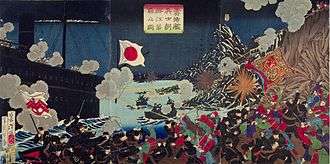Ganghwa Island incident
| Battle of Ganghwa | |||||||
|---|---|---|---|---|---|---|---|
.jpg) Japanese marines landing from the Unyo at Yeongjong Island which is near Ganghwa. | |||||||
| |||||||
| Belligerents | |||||||
|
|
| ||||||
| Commanders and leaders | |||||||
| Inoue Yoshika | Unknown | ||||||
| Strength | |||||||
|
Land: 22 sailor and Marine Sea: 1 gunboat |
Land: 500 infantry Artillery pieces | ||||||
| Casualties and losses | |||||||
|
1 killed 1 wounded |
35 killed 16 captured 36 artillery piece and small cannon captured 1 fort destroyed | ||||||
The Ganghwa Island incident or the Japanese Battle of Ganghwa (Korean: 운요호 사건 [雲揚號事件] Unyo-ho sageon meaning "Un'yō incident"; Japanese: 江華島事件 Kōkatō jiken), was an armed encounter between the Joseon Dynasty of Korea and Japan which occurred in the vicinity of Ganghwa Island on September 20, 1875.
Background
In the second half of the 19th century, the Korea peninsula was the scene of a power struggle between several imperial powers including the Russians and the French, as well as the Chinese and the Japanese.
The Meiji Restoration of 1868 ended the 265-year-old feudalistic Tokugawa shogunate in Japan. The new government of Japan sent a messenger holding a letter with the sovereign's message which informed of the founding of a new administration of Japan to the government of the Korean Joseon Dynasty on December 19, 1868.
However, the Koreans refused to receive the letter because it contained the Chinese characters 皇 ("royal, imperial") and 勅 ("imperial decree").[1] According to the political system of the day, only the Chinese emperor was allowed to use these characters, as they signified the imperial authority of China.[1] Hence, their use by a Japanese sovereign was considered unacceptable to Joseon Korea, as it implied he was an equal of the emperor of the China.[2]
The Chinese suggested to the Koreans to receive the sovereign letter from Japan, because China knew the power of Japan at that moment.[3] Despite government-level negotiations held in 1875 at Busan, no substantial progress was made. Instead, tension grew as the Koreans continued to refuse to recognize Japan's claims of equality with China.
Battle of Ganghwa
In 1875, the Un'yō, a small Japanese warship under the command of Inoue Yoshika, was dispatched to survey coastal waters without Korean permission.
On September 20, the ship reached Ganghwa Island, which had been a site of violent confrontations between Korean forces and foreign forces in the previous decade. In 1866, the island was briefly occupied during the French expedition against Korea, and in 1871 subject to an American expedition.

The memories of those confrontations were very fresh, and there was little question that the Korean garrison would shoot at any approaching foreign ship. Nonetheless, Commander Inoue ordered a small boat launched – allegedly in search of drinkable water. The Korean forts opened fire. The Un'yō brought its superior firepower to bear and silenced the Korean guns, then sent a landing force ashore to fight the Koreans on land. The Japanese ended their attack and withdrew back to Japan.
Aftermath
The number of casualties is unknown. After the incident, the Imperial Japanese Navy blockaded the immediate area and requested an official apology from the Joseon government, which was concluded with the dispatch of the Kuroda mission and the signing of the Treaty of Ganghwa on February 27, 1876, which opened the Korean Peninsula to Japanese and foreign trade.
See also
Notes
References
- Duus, Peter (1998). The Abacus and the Sword: The Japanese Penetration of Korea. University of California Press. ISBN 0-52092-090-2.
- Jansen, Marius B. (2002). The Making of Modern Japan. Harvard University Press. ISBN 0-6740-0334-9.
